Waterjet cutting and plasma cutting aid in cutting and fabricating metal and other materials, but they differ considerably. These differences range from materials cut to the speed of cutting and even finishing.
Besides, there are cutting needs that require using the waterjet technique over the plasma cutting technique, and vice versa. So, waterjet vs plasma cutting – which is best or the right technique?
Here we discuss these cutting techniques and the differences between waterjet cutting and plasma cutting in terms of their working principles, ideal materials, and cost. That way, you know the right technique to use.
Waterjet vs Plasma Cutting: Comparing Differences Between Them
Waterjet and plasma cutting are used to cut materials to desired shapes. However, there are remarkable differences between them. Let us examine these differences in detail.
Working Principle
Waterjet Cutting
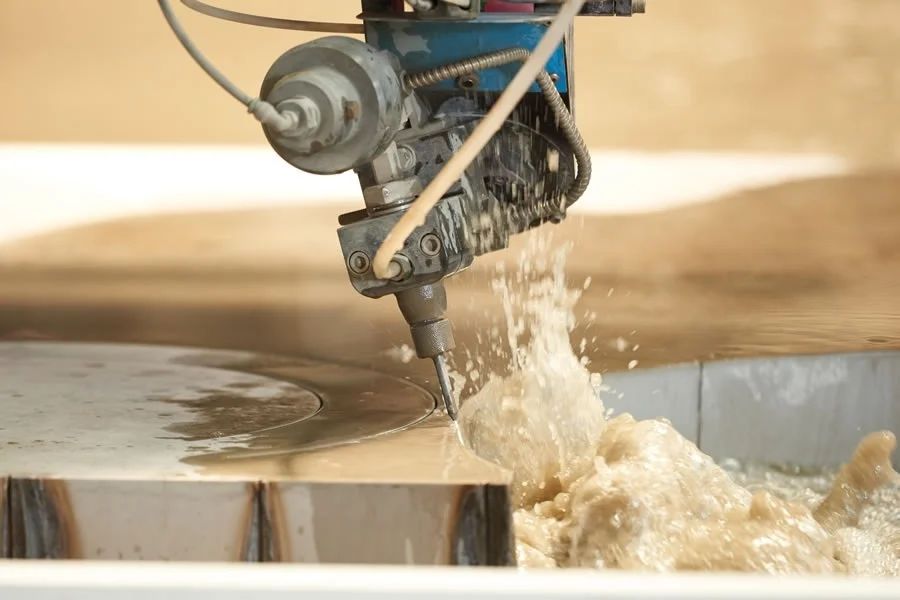
The waterjet cutting system breaks down materials by pushing a mixture of water and an abrasive (usually garnet) through a ceramic nozzle. This mixture comes out of the nozzle with a pressure reaching over 50,000 PSI, allowing it to cut almost any material. In other words, a waterjet cutting system is a high-speed erosion system.
Plasma Cutting
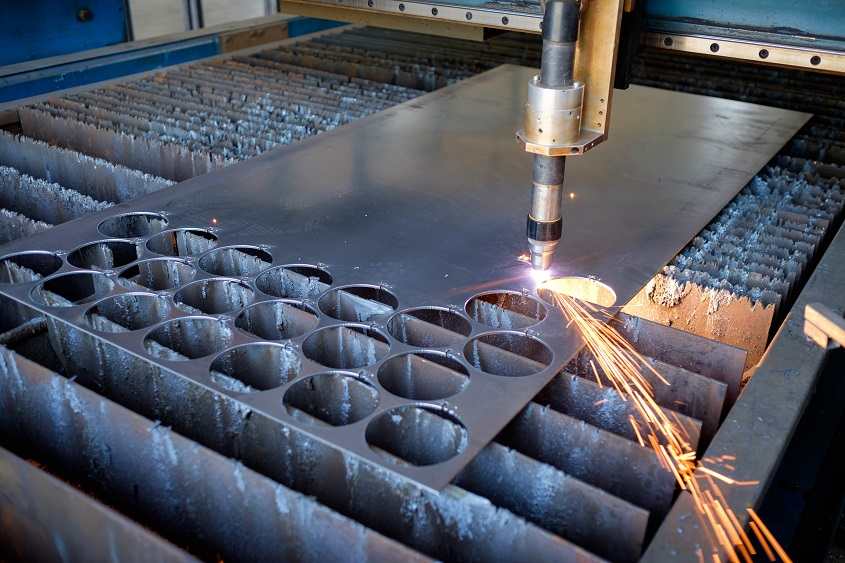
Unlike waterjet cutting, plasma cutting uses compressed gasses and electricity for cutting materials. The process involves forcing the compressed gas through a constricted opening at high pressure, where it gets in contact with an electric arc.
When it gets in contact with this electric arc sent through a nozzle, it causes a reaction. The gas used for this process could be nitrogen, oxygen, argon, etc., depending on the metal type and thickness. Also, this gas undergoes heating until it reaches a particular temperature level and enters the fourth state of matter – plasma. The plasma produced during this process is so hot that it can cut cleanly through metal at high speed.
Material Selection
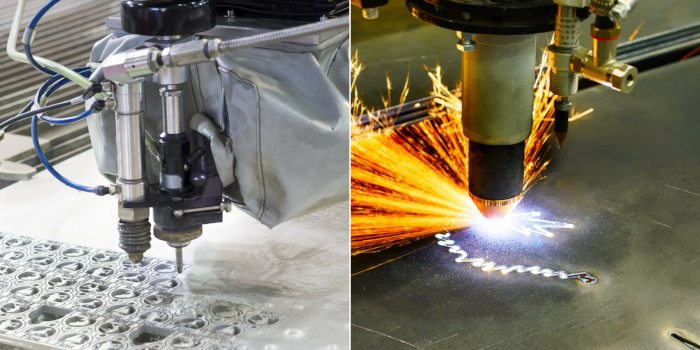
Although both techniques can cut metals, there is a disparity in the range of materials they can cut comfortably and material thickness.
Flexibility To Materials
In the flexibility of materials, waterjet takes the upper hand. The reason is that it can cut through almost every material on earth. However, common metal materials it can cut include steel, aluminum, and copper. It can also cut other materials like Styrofoam, rubber, textiles, and paper.
On the other hand, the plasma cutting technique can only cut conductive metals. It creates the plasma arc used for cutting by binding electrons to a gas. Nonetheless, this places a limit on its cutting ability when compared to the water jet. However, since most metals are conductive, this does not pose a cutting challenge. Common metals cut using plasma cutting include aluminum, steel, copper, alloys, gold, titanium, and stainless steel.
So for material selection, waterjet cutting wins the waterjet vs plasma cutting debate!
Material Thickness to Cut
Material thickness is another factor that differentiates plasma cutting from waterjet cutting. A waterjet cutting machine can cut thick steel or stainless steel up to 6 inches in thickness and 18 inches for materials other than metals. Furthermore, this technique can cut up to 100 ft thickness when used for processes such as coal mining.
On the other hand, plasma cutting has a limitation on its cutting depth, being able to cut thick mild steel up to 6 inches only. However, for metals with standard thickness, both techniques work optimally.
During the Process
Differences between waterjet and plasma cutting also lie in the processes of using both techniques. You find such differences in the following;
Productivity and Cutting Speed
Material properties that affect speed include the type of material, cut complexity, material thickness, and design accuracy. When cutting a thick metal sheet, plasma cutting is the fastest, with an average cutting speed of about 200 inches per minute. Conversely, between waterjet cutting and plasma cutting, the waterjet is slow, with an average cutting speed of 15 inches per minute.
With higher cutting speeds, there is an enhancement in productivity when cutting metals with the plasma cutting technique.
The Complexity of Cuts
When making cuts that are at an angle, have indentions, or have a smooth cut edge, waterjet cutting is ideal. It allows a greater complexity in cutting, giving fabricators more flexibility. In other words, it becomes easier to cut complex shapes from metals and other materials with a waterjet cutter. Also, an advanced waterjet cutter makes it easier to select the ideal pressure needed to cut indents into metal without cutting through.
Plasma cutting, on the other hand, must cut through the material being cut to make the desired design. This makes fabricating indents and other complex cuts impossible. However, plasma cutting is ideal for making relatively simpler cuts.
Stress Effects During Cutting
Plasma cutting causes warp, distortion, and other forms of stress to the material being cut. This is due to the high temperatures experienced during the process. Conversely, a waterjet cutting machine does not create this type of stress because no intense heat is experienced during the process.
So, if you are cutting a material that is stress-sensitive, it is best to avoid using the plasma cutting technique for better quality.
Heat-Related Effects
Heat-related effects occur with materials fabricated using the plasma cutting technique. This is primarily because the process involves using high temperatures to melt and cut materials. Also, the gas used during the process produces a chemical reaction close to the melted part, often changing the color and chemical composition of those parts.
However, when cutting with a water jet, heat-related effects are non-existent since the process does not involve the use of heat. This makes the waterjet cutting system ideal for use where promoting overall integrity and quality is necessary.
Environmentally Friendly
Waterjet cutting is more environmentally friendly than plasma cutting for many reasons. Firstly, it is a closed-loop operation, where the water used for cutting undergoes recycling during the process. Furthermore, recycling all the metals cut during the process as scrap metal is possible.
On the other hand, plasma cutting produces fumes during the process, thereby negatively impacting the atmosphere. Also, the melted metal forms dross, which is the product of its reaction with gasses and water.
Energy Consumption
Plasma cutting is an energy-consuming process. This is due to the pressure required for the gas and the electric arc at the cutting location. On the other hand, the waterjet technique consumes less power since it only requires a high-pressure water pump during the process.
In other words, plasma-cutting machines consume more than two times the energy consumed by waterjet-cutting machines.
Final Results
The final result you want to achieve with cutting is also one of the differences between plasma cutting and waterjet cutting. The parameters for final results include;
Product Quality
Tolerance and accuracy are hallmarks of product quality. Tolerance is the distance of the cut from the original area intended. Consequently, the tolerance for plasma cutting is around 0.015 inches. However, entry-level plasma cutting has a significantly higher tolerance value.
On the other hand, Waterjet cutting has a tolerance of 0.001 inches. In other words, it has greater accuracy. The tolerance level and accuracy of waterjet cutting give it a better cut quality that consequently requires little to no finishing. So for product quality, waterjet cutting wins the plasma vs waterjet cutting argument.
Finishing Requirements
Plasma cutting requires secondary finishing because of its low precision and accuracy. Secondary metal finishing in this aspect comes from fine grinding, which helps improve the edge quality of the cut surface.
On the other hand, waterjet cutting does not require secondary finishing because the surface is already precise. In other words, by choosing waterjet cutting over plasma cutting, you save cost on secondary finishing processes.
Cutting Machines-Related
So, what about the cutting machines? How do plasma cutters compare to waterjet cutters in terms of safety, lifespan, and maintenance?
Safety
Waterjet cutting machines are relatively safe. This is due to the total absence of high temperatures and open currents. Also, the safety rating of cutters used here is good since the equipment usually holds a water bed that eliminates the water pressure.
On the other hand, plasma cutters and cutting produce electric currents as well as heat at very high temperatures. Consequently, it is a process that requires a lot of training as regards safety before handling. Also, it is recommended that fabricators that use this technique use safety goggles or glasses, as the technique is dangerous to the eye.
Lifespan
The consumables used in plasma cutting wear out very quickly. For instance, the nozzle only lasts a few hours before requiring change. True, the time spent on fabrication using this technique is short, but material wear is fast due to the high pressure and temperature of gasses.
On the other hand, consumables like the nozzle used in waterjet cutting have a longer lifespan, often lasting about 100 hours. Parts like the pressure pump last longer, lasting about 10,000 hours.
Also, a shorter lifespan for consumables used in plasma cutting increases production costs, as replacing worn consumables is expensive. Conversely, with the waterjet cutter, there is little need for the replacement of consumables, translating to a lower cost of production.
Maintenance
Since there is no complex equipment involved in waterjet cutting, maintenance is a simple process. Also, the lack of wear and tear of consumables enhances the ease of maintenance. On the other hand, plasma cutting maintenance is a tad more complex due to the frequent change of worn nozzles and electrodes.
Applications
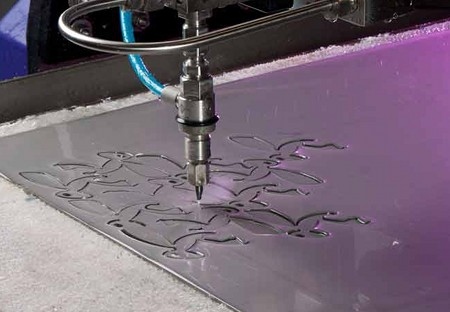
Waterjet cutting is not material-selective. It can cut through almost any material with a high degree of precision. This gives it application in manufacturing parts for the mining and aerospace industries.
On the other hand, plasma cutting cuts through materials that can conduct electricity, like thick mild steel. This is why it has applications in fabricating products used in industrial construction and similar applications.
Costs
Cost is a major differentiating factor between these cutting techniques. When comes to investing in a CNC plasma vs waterjet cutting machine the plasma cost is lower. Acquiring a professional CNC plasma cutter costs anywhere between $50,000 to $100,000. A waterjet cutter cost is infinitely more expensive, costing between $100,000 to $350,000. So for upfront costs, plasma-cutting machines are cheaper.
Also, plasma-cutting machines are lesser for costs of operation, with a budget of $15 per hour, making large-scale production easier. The operating cost for waterjet cutters is higher due to the cost of acquiring the abrasive material used during the process. Although the abrasive costs around 75% of the cost of using the waterjet cutting technique, it costs about $30 per hour.
Therefore for both upfront and running costs, the plasma cutting technique is better than the waterjet technique.
When to Choose Waterjet Cutting Over Plasma Cutting?
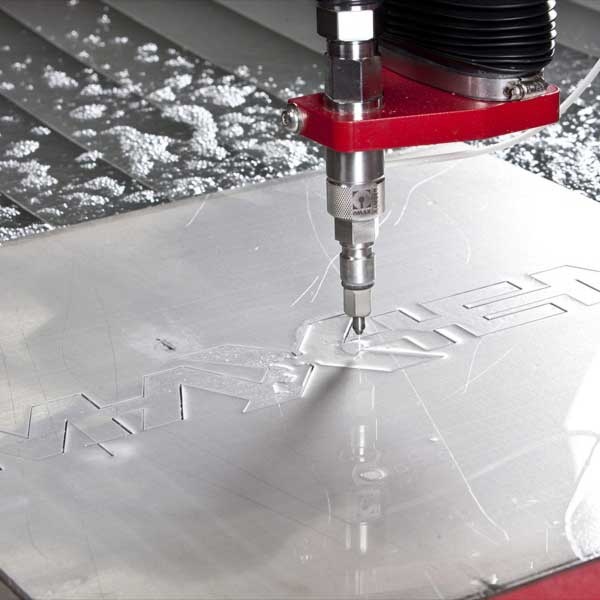
Both cutting techniques have their merits and demerits, but here is why you should choose waterjet cutting over plasma cutting;
- Higher level of accuracy and precision due to very low tolerance.
- The edge quality produced by plasma-cut stainless steel does not match that produced by waterjet cutting. Also, the plasma cut ones do not meet industry standards.
- It is a more environmentally friendly technique due to the water and metal recycling that occurs and can occur during the process.
- Ideal for cutting materials like granite that do not melt easily.
- It is perfect for cutting materials that melt easily on exposure to heat.
- Waterjet cutting occurs at a lower temperature, and heat-affected zones do not exist.
When to Choose Plasma Cutting Over Waterjet Cutting
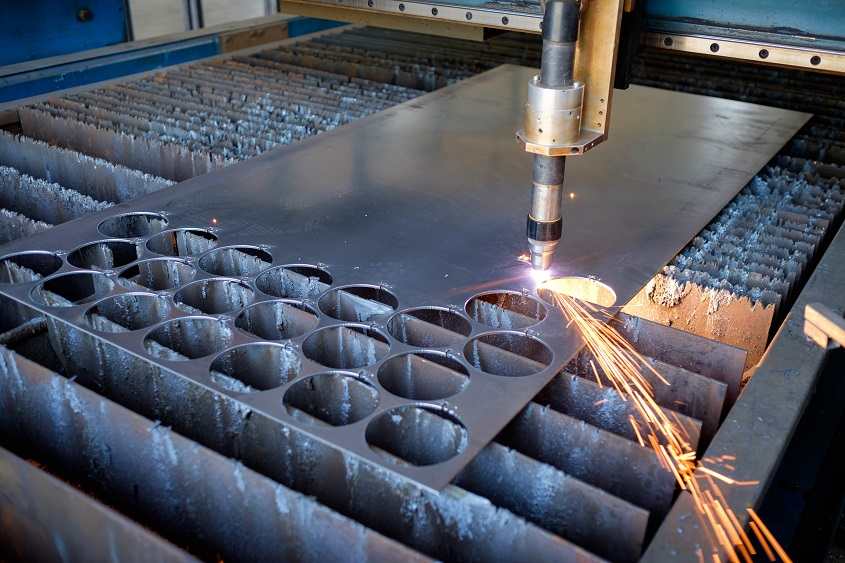
Here are some advantages of choosing plasma cutting over water cutting.
- It has a fast cutting time of 200 inches per minute, which increases the rate of productivity and saves time.
- It is a cheaper process, as both its upfront and running costs are cheaper than what is obtainable when using the waterjet cutting technique.
- With specialized equipment, this process can occur underwater.
Choose the Suitable One to Make Your Precision Cut Parts
So, what is your verdict on the waterjet vs plasma cutting debate? Anyway, now that you know more about waterjet cutting and plasma cutting, choosing the suitable one for your precision-cut parts becomes easier. We also discussed the merits both processes have over the other, as well as differences in working principles, material selection, application, and cost.
Are you looking to make a precision-cut part? Why expose yourself to risks when you can outsource the part production to certified manufacturers? At RapidDirect, we provide several precision cutting services, including; laser cutting, and plasma cutting services .
We also boast a team of strong, dedicated engineers who help ensure parts produced are of the highest possible quality. All you need to do is upload your design files to our platform to get a rapid quotation as well as a free DFM analysis. So why wait? Contact us today for your precision-cut parts.


